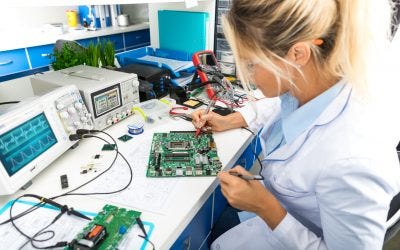Frost & Sullivan study shows that COVID-19 has dented machine-to-machine device sales, thus impacting IoT and, subsequently, the test and measurement market, but there are exceptions.
August 5, 2020

Frost & Sullivan’s recent study, Growth Opportunities in Test and Measurement in the IoT Market, Forecast to 2025, finds that the proliferation of machine-to-machine (M2M) devices will decrease during 2020 due to COVID-19. This will have a significant impact on the demand for testing equipment that validates their performance. The exception is equipment for connected health applications. The study shows growth rebounding by 2021, with revenue ultimately expanding at annual growth rate of 5.1% to reach $3.25 billion by 2025, up from $2.40 billion in 2019.

5G Development Bolstered by the Health Crisis
COVID-19 has produced mixed results in the deployment of 5G in IoT. For one, the need for 5G in medical has prompted development, while in other markets, the health crisis has been a damper. 5G development for IoT use cases in medical will important during the pandemic. Given the complex nature of its deployment, there will requirements for software-based testing solutions that can test virtualized 5G network slices as well as test broad frequency spectrums
Yet 5G development for IoT uses cases outside medical has been diminished by the pandemic. “Initially, the 3GPP were set to finalize Releases 16 and 17 by the end of 2020. That contained important new features pertinent to IoT for the 5G spectrum. This has been postponed due to the pandemic.,” Rohan Joy Thomas, an industry analyst in the industrial practice at Frost & Sullivan, told Design News. “As a result, Frost & Sullivan expects a 5G deployment that is capable of sustaining an IoT ecosystem towards the end of 2021, subject to how COVID-19 plays out across the globe.”
The Medical Industry Is the Current Shining Star for Test and Measurement
Before COVID-19, the automotive electronics market was one of the bright examples of the power of effective IoT. “Prior to the pandemic, connected car applications were expected to experience a higher degree of growth. But now, Frost & Sullivan expects a rise in connected healthcare over other IoT applications,” said Thomas. “This is due to an increase in telemedicine applications, which were used extensively for COVID-19.”
Prolonged healthcare demands are driving up the market for medical beyond pre-COVID-19 growth expectations. “As the battle against COVID-19 continues, it will enhance the growth in this sector,” said Thomas. “While the IoT test and measurement is expected to grow at a CAGR (compound annual growth rate) of 5.1% from 2019 to 2025, connected healthcare is expected to grow at 8.8% during that same period.”
Preparing for a Post-COVID-19 Market
Even while the pandemic is wreaking havoc with the IoT market – and thus test and measurement – the market’s growth beyond COVID-19 is likely to resume. Thus, the Frost & Sullivan study projects a proliferation of IoT across multiple industries. The study notes this presents immense growth opportunities for market participants involved in the IoT test and measurement space. Frost & Sullivan recommends that they:
Develop solutions that can test high-speed Ethernet interfaces as well as physical entities
Provide over-the-air testing solutions that can test sub-6 gigahertz as well as higher millimeter wave applications
Introduce enhanced software testing capabilities along with artificial intelligence, machine learning, and cybersecurity to enhance the portfolio
Provide solutions that can regulate the consumption of energy from connected devices operating at narrowband frequencies and low energy levels, thereby increasing the device's longevity
Rob Spiegel has covered automation and control for 19 years, 17 of them for Design News. Other topics he has covered include supply chain technology, alternative energy, and cybersecurity. For 10 years, he was the owner and publisher of the food magazine Chile Pepper.
About the Author(s)
You May Also Like





